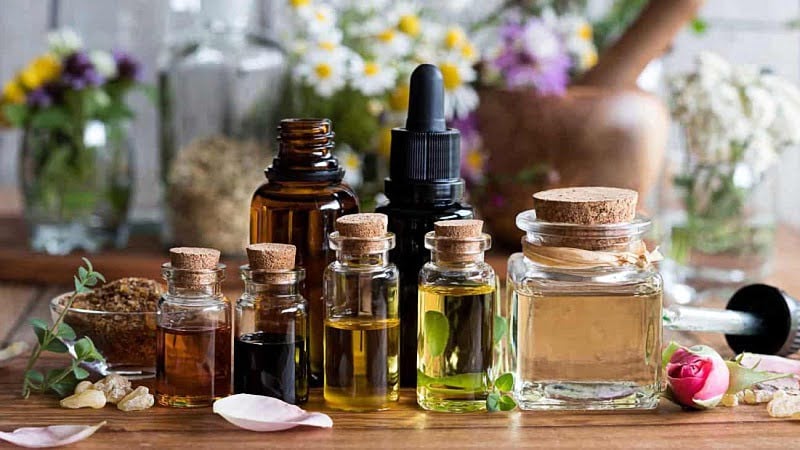Difference between Terpenes and Essential Oils

Terpenes are just one sub-group of the many volatile components found in plants. The collective extraction of all volatile compounds is referred to as an essential oil.
Essential oils can also contain oxides, ketones, phenols, esters, alcohols, and much more.
However, the term terpenes usually refer to the total volatile extract of plants, especially in cannabis.
The difference is semantics. Terpenes and essential oils are often used synonymously when describing the aromatic, volatile compounds extracted through steam distillation.
What Are Terpenes?
Terpenes are natural compounds that provide the unique smell and flavor of plants.
There are also a few species of fungi and insects that make them.
Terpenes, like other plant-based phytochemicals, are very diverse. They’re derived from isoprene, but their chemical structure can vary significantly. Some contain simple molecules composed of only a few elements; others are wildly complex.
Terpenes are divided into different categories:
- Monoterpenes are a type of terpene constructed from two isoprene units. These terpenes have a molecular formula of C10H16.
- Diterpenes are made of two terpene units and most often have the molecular formula C20H32. Instead of two isoprene units, they have four.
- Polyterpenes contain up to several hundred isoprene units and make up natural materials like rubber.
Monoterpenes and diterpenes are allelopathic agents — organisms that produce biochemicals that influence other organisms [1].
Despite all the complex terminology surrounding terpenes, you’re already familiar with them. We’re exposed to terpenes daily, whether that means breathing in the smell of pine caused by pinene or the scent of fresh lemon produced by limonene.
What Are Essential Oils?
Essential oils have been a part of traditional medicine for centuries and are used now for various purposes.
To extract these oils, plants are steam or cold-pressed. Some oils, usually citrus, are mechanically expressed. It can take pounds of a plant to produce a small amount, hence the high cost of quality essential oil.
Essential oils contain all the volatile spectrum from the plants they’re derived from — not just the terpenes.
Are Essential Oils & Terpene Extracts the Same?
It might sound like essential oils and terpene extracts are the same thing. They are indeed similar, but there are some key differences.
The main difference is that essential oils contain all the volatile components in a given plant species, while terpenes are isolated and removed from everything else.
For example, the essential oil of lime may contain high concentrations of limonene, but there will be dozens of other compounds in there as well.
A limonene terpene extract contains 99% pure limonene and nothing else.
What are Essential Oils & Terpenes Used For?
Aromatherapy — an alternative medicine used for symptom management — uses essential oils as a source of medicine [2].
Terpenes can be used in the same way but lack other necessary plant components.
Both are flavor or scent enhancers as well — often used in perfumes and food.
Most cannabis products on the market these days use terpene extracts or essential oils as a source of flavoring.
Using Essential Oils & Terpenes
There are many different ways to use essential oils and terpenes, and each method has distinct benefits.
1. Inhalation & Vape Additives
The safest and most common method is through smell. Terpenes and essential oils are absorbed through the nasal cavity, affecting the olfactory receptors.
An aroma alone can influence these receptors if you have a strong memory associated with it.
This administration is usually the best for the uplifting and mood-supportive benefits of certain terpenes or essential oil extracts.
2. Topical Applications
Topical use of essential oils and terpenes, undiluted, is not recommended. They’re very potent and can easily lead to dry skin or negative reactions like rashes and itching.
First, make sure the oil you’re planning to use is safe for your skin. Second, you’ll need to dilute it properly. Many oils and terpenes can be applied to the skin if they’re diluted in a carrier oil. Once the essential oil is at the proper concentration, you can enjoy using them in several ways.
Use these oils topically if you’re looking to soothe your skin or an injury.
3. Oil Infusions & Edibles
Terpenes and essential oils can be used internally — but they need to be diluted first.
When you order a bottle of CBD oil flavored with terpenes, the total terpene concentration rarely exceeds 3%. These compounds are so potent you only need a few drops to impart a strong flavor throughout the whole bottle.
Under no circumstance should you consume pure essential oils. In concentrated forms, terpenes and essential oils can cause irritation, inflammation, and damage to the skin or internal organs.
Essential Oils & Terpenes: What’s The Difference?
The term terpenes and essential oils technically refer to different substances — but the difference is more or less semantics. Most people use these terms synonymously.
Technically, terpenes are one specific subset of the volatile components found in plants. There are also oxides, alcohols, phenols, and ketones.
Essential oils refer to the entire spectrum of compounds derived from the source plant. They’re made through steam distillation which causes all the volatile components to evaporate, where they’ve later collected in liquid form once again.
Terpene extracts may consist of just one concentrated terpene or a blend of terpenes.
Essential oil is the holistic extraction of the plant, which contains any number of different compounds.
